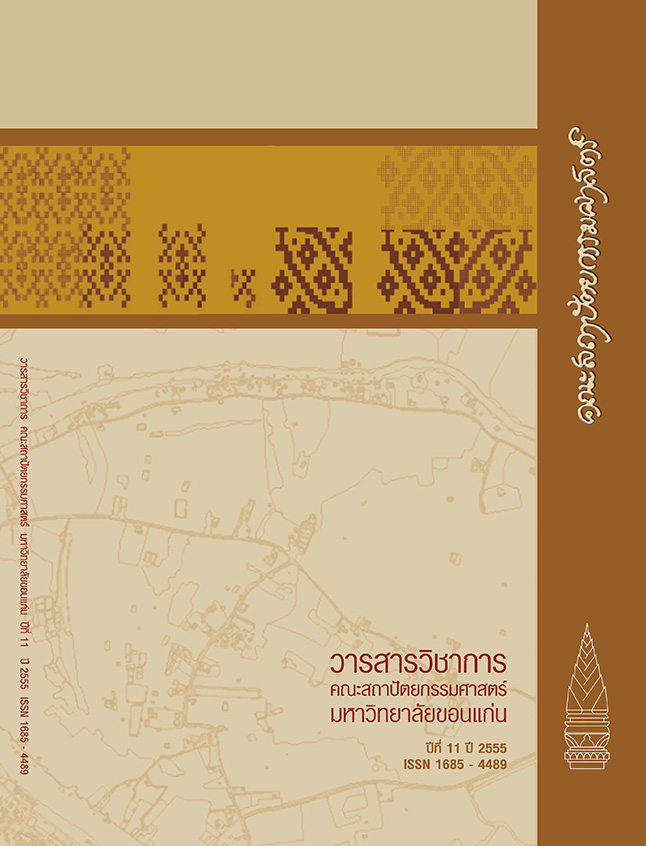สถาปัตยกรรมพื้นถิ่นในบริบทพลวัตภูมิทัศน์วัฒนธรรม: กรณีศึกษา ชุมชนชาวแพ แม่นํ้าสะแกกรัง จ.อุทัยธานี
คำสำคัญ:
สถาปัตยกรรมพื้นถิ่น, ภูมิทัศน์วัฒนธรรม, ชุมชนชาวแพ, Vernacular Architecture, Cultural Landscape, Raft-House Communityบทคัดย่อ
ภูมิทัศน์วัฒนธรรมเกิดจากการผสมผสานกันระหว่างองค์ประกอบภูมิทัศน์ทั้งทางวัฒนธรรม และธรรมชาติของท้องถิ่นส่งผลให้เกิดเป็นเอกลักษณ์เฉพาะตัวของพื้นที่แห่งนั้น ซึ่งสามารถรับ รู้ความเป็นท้องถิ่นหรือความเป็นถิ่นที่นั้นๆได้อย่างชัดเจนเมื่อองค์ประกอบของภูมิทัศน์ในพื้นที่ แห่งนั้นมีความชัดเจนและเป็นเอกภาพบทความทางวิชาการนี้เป็นข้อสังเกตที่ได้จากโครงการวิจัย “แนวทางการอนุรักษ์มรดกทางวัฒนธรรมที่มีลักษณะทางภูมิทัศน์วัฒนธรรม ที่โดดเด่นเพื่อ ส่งเสริมการท่องเที่ยวอย่างยั่งยืน: กรณี ชุมชนเรือนแพและชุมชนริมแม่นํ้าสะแกกรัง จังหวัด อุทัยธานี” ซึ่งได้ใช้ระเบียบวิธีการดำเนินการวิจัยที่เน้นเชิงคุณภาพเป็นหลัก แต่ยังคงผนวกกับการ ศึกษาสังเกตถึง รูปแบบการตั้งถิ่นฐานรูปแบบการจัดวางผังและการใช้ที่ดินระดับชุมชน รูปแบบ การจัดวางผังบริเวณและการใช้ที่ดินโดยรอบตัวเรือนองค์ประกอบภูมิทัศน์และรูปแบบพื้นที่ใน เชิงสังคมผลจากการศึกษาวิจัยพบว่าภูมิทัศน์วัฒนธรรมของพื้นที่ศึกษาเกิดจากการที่ชาวชุมชน ได้ปรับเปลี่ยนรูปทรงทางสถาปัตยกรรมพื้นถิ่นเรือนเพื่อการอยู่อาศัยและสภาพแวดล้อมโดยให้ สัมพันธ์กับการจัดวางเนื้อที่ใช้งานทั้งภายในและภายนอกเพื่อตอบสนองกิจกรรมในการดำรง ชีวิตได้อย่างเหมาะสม และประสานกลมกลืนกัน ตลอดจนมีการใช้วัสดุก่อสร้างที่แสดงถึงสัจจะ ของธรรมชาติของวัสดุในท้องถิ่น
Vernacular Architecture in the DynamicContext of Cultural Landscape: TheRaft-House Community Case Study, Sagae-Krang River, Uthai-Thani Province
For better understanding in the identity of cultural landscape, the unique mixtures of cultural and natural environments including man-made environments have to be explored. According to the research, an approach of cultural heritage conservation for the distinctive cultural landscape towards sustainable tourism: a case of raft-house and riverside community,Sagae-Krang River, Uthai-Thani province, this particular paper examines the cultural landscape characteristics through the explanation of the pattern of settlement and its surrounding, and building use and its space arrangement. The research conducted fi eld research on cultural landscape community,Segae-Krang Raft-House Community, in Uthai-Thani Province. The study mainly used qualitative techniques of primary data gathering - focus-group and individual in-depth interviews. These were combined with on-site observation and records reviews for triangulation of information. The researchfi ndings illustrate that the community consist of both tangible and intangible aspects of the cultural landscape. The local people in the community can adapt themselves to respond to globalization and demands in their daily lives. However, at the same time, they still maintain their cultural landscape characteristics.
ดาวน์โหลด
รูปแบบการอ้างอิง
ฉบับ
ประเภทบทความ
สัญญาอนุญาต
ทัศนะและข้อคิดเห็นของบทความที่ปรากฏในวารสารฉบับนี้เป็นของผู้เขียนแต่ละท่าน ไม่ถือว่าเป็นทัศนะและความรับผิดชอบของกองบรรณาธิการ




